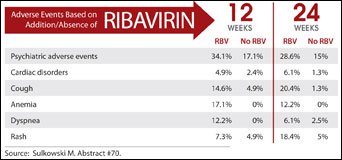Ribavirin Added to Daclatasvir, Sofosbuvir Increased Adverse Events
Click Here to Manage Email Alerts
NEW YORK — A daclatasvir plus sofosbuvir regimen with or without ribavirin appeared to be well tolerated in patients with chronic hepatitis C virus infection, but the addition of ribavirin increased the incidence of adverse events, according to data presented at the AASLD/EASL Special Conference on Hepatitis C.
Mark Sulkowski, MD, Johns Hopkins University, and colleagues conducted a parallel-group, open-label study to evaluate the effects that adding ribavirin (RBV) to a daclatasvir (DCV) plus sofosbuvir (SOF) regimen had on safety outcomes. They randomly assigned 211 patients to 60 mg oral DCV once daily plus 400 mg SOF with or without RBV twice daily for 12 weeks in genotype (GT)-1 treatment-naive patients and for 24 weeks in GT 1, 2, or 3 treatment-naive patients and GT-1 patients with telaprevir or boceprevir failure.

Mark Sulkowski
The most common adverse events (AE) were fatigue, headache, nausea, arthralgia and diarrhea, which occurred at similar rates regardless of treatment type and duration. Serious AE, grade 3/4 AE and AE that led to discontinuation also were similar in RBV and non-RBV groups. Psychiatric AEs (34.1% vs. 17.1%, 12 weeks; 28.6% vs. 15%, 24 weeks) and cardiac disorders (4.9% vs. 2.4%, 12 weeks; 6.1% vs. 1.3%, 24 weeks), however, occurred more frequently in RBV groups. AEs most commonly associated with RBV occurred more frequently, including cough (14.6% vs. 4.9% and 20.4% vs. 1.3%), anemia (17.1% vs. 0% and 12.2% vs. 0%), dyspnea (12.2% vs. 0% and 6.1% vs. 2.5%), rash (7.3% vs. 4.9% and 18.4% vs. 5%), insomnia (14.3% vs. 5%, 24 weeks) and anxiety (4.9% vs. 0% and 10.2% vs. 5%). Graded hemoglobin also decreased further and more frequently in the RBV group (grade 1-2, 53%; grade 3, 15.6%) compared with non-RBV patients (grade 1-2, 9.1%; grade 3, 0%), and decreases in mean hemoglobin levels were greater (–2.76 g/dL vs. –0.93 g/dL, 12 weeks; –2.32 g/dL vs. –0.56, g/dL, 24 weeks).
“While DCV/SOF with or without RBV was generally well-tolerated, the addition of RBV was associated with increased AEs, including psychiatric AEs, cardiac disorders and anemia,” the researchers concluded. “RBV-sparing, oral HCV treatment regimens warrant further investigation.”
For more information:
Sulkowski M. Abstract #70. Presented at: AASLD/EASL Special Conference on Hepatitis C; Sept. 12-13, 2014; New York.
Disclosure: See the abstract for a full list of relevant financial disclosures.

